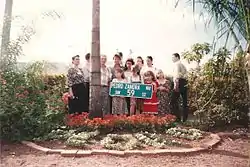Cuban exile
A Cuban exile is a person who emigrated from Cuba in the Cuban exodus. Exiles have various differing experiences as emigrants depending on when they migrated during the exodus.[1]
.jpg.webp)
Demographics
Social class
Cuban exiles would come from various economic backgrounds, usually reflecting the emigration wave they were a part of. Many of the Cubans who would emigrate early were from the middle and upper class, but often brought very little with them when leaving Cuba. In response, Cuban exiles were pejoratively referred to by critics on the island as "gusanos". Small Cuban communities were formed in Miami, the United States, Spain, Costa Rica, Uruguay, Italy, Canada, and Mexico. By the Freedom Flights, many emigrants were middle class or blue-collar workers, due to the Cuban government's restrictions on the emigration of skilled workers. Many exiled professionals were unlicensed outside Cuba and began to offer their services in the informal economy. Cuban exiles also used Spanish language skills to open import-export businesses tied to Latin America. By the 1980s many businesses owned by Cuban exiles would prosper and develop a thriving business community. The 1980 Mariel boatlift saw new emigrants from Cuba leaving the harsh prospects of the Cuban economy.[2]
Queer Cubans

Between 1965 and 1968, the Cuban government interned LGBTQ Cubans, along with others deemed deviant who would not or were not allowed to serve in military, into labor camps called the Military Units to Aid Production. Outside the labor camps, there would be prevalent discrimination and prejudiced ideation against LGBT members of Cuban society, and homosexuality would not be decriminalized until 1979. LGBTQ Cubans notably tried to escape the island either by enlisting in the Cuban military to be deployed abroad, or by emigrating in the Mariel boatlift where LGBTQ Cuban prisoners were specifically targeted by authorities to be given approval to emigrate.[3]
The male exiles of the Mariel boatlift were depicted by the Castro administration as effeminate and often pejoratively addressed with homophobia by leaders. Revolutionary masculinity (machismo) and an association of homosexuality with capitalism had fostered homophobic sentiments in Revolutionary Cuban culture. This atmosphere had driven many LGBTQ Cubans to flee when Castro announced he would allow the exodus. By 1980 homosexuality was no longer criminalized by Cuban law, but queer Cubans still faced systemic discrimination. There was a social phenomenon of straight men pretending to be gay to pass the interviews required of applicants for the exodus, because it was believed that homosexuals were more likely to pass the panel held to determine if a person could exit from Cuba. Communities of gay exiles formed in the processing centers that formed for those applying for entry to the United States. These centers kept their gender populations segregated. As a result, a majority of reports of LGBTQ Cuban Exile communities in these centers were focused on gay male exiles. However, secondhand reports suggested parallel lesbian communities had formed in the women's population. Though United States law technically barred emigration into the country on grounds of homosexuality, exceptions were made for the exiles to support them as anti-communists. Only LGBTQ people who clearly and explicitly told the US immigration panel that they identified as such were denied entry to the United States.[4]
Author Susana Pena has written about LGBTQ people in the Mariel boatlift and has speculated that their resettlement in Miami may have spurred on a revival of LGBTQ social life in Miami's South Beach.[5]
Afro-Cubans
While fewer Afro-Cuban exiles arrived in the earlier waves of migration, Afro-Cuban presence was larger among the Mariel Boatlift and Balseros periods. Anywhere between 20% and 40% of Marielitos were identified as black. A substantial portion of Afro-Cuban exiles assimilated into the African American community, but some remain active in the Cuban-American community.[6]
References
- Pedraza-Bailey, Silvia (1985). "Cuba's Exiles: Portrait of a Refugee Migration". International Migration Review. 19 (1): 4–34. doi:10.1177/019791838501900101. PMID 12267275. S2CID 220349976.
- Miguel González-Pando. "DEVELOPMENT STAGES OF THE "CUBAN EXILE COUNTRY"1" (PDF). ascecuba.org. Association for the Study of the Cuban Economy.
- Capo, Julio (2010). "Queering Mariel: Mediating Cold War Foreign Policy and U.S. Citizenship among Cuba's Homosexual Exile Community, 1978–1994". Journal of American Ethnic History. 29 (4): 84–88. doi:10.5406/jamerethnhist.29.4.0078. JSTOR 10.5406/jamerethnhist.29.4.0078.
- JR., JULIO CAPÓ (2010). "Queering Mariel: Mediating Cold War Foreign Policy and U.S. Citizenship among Cuba's Homosexual Exile Community, 1978–1994". Journal of American Ethnic History. 29 (4): 78–106. doi:10.5406/jamerethnhist.29.4.0078. ISSN 0278-5927. JSTOR 10.5406/jamerethnhist.29.4.0078.
- Jesse Monteagudo. "The Mariel Boatlift: When Gay Cubans Took Over Miami". southfloridagaynews.com. South Florida Gay News.
- Gosin, Monika (2017). ""A bitter diversion": Afro-Cuban immigrants, race, and everyday-life resistance". Latino Studies. 15: 4–28. doi:10.1057/s41276-017-0046-2. S2CID 151520420. Retrieved 2021-01-16.